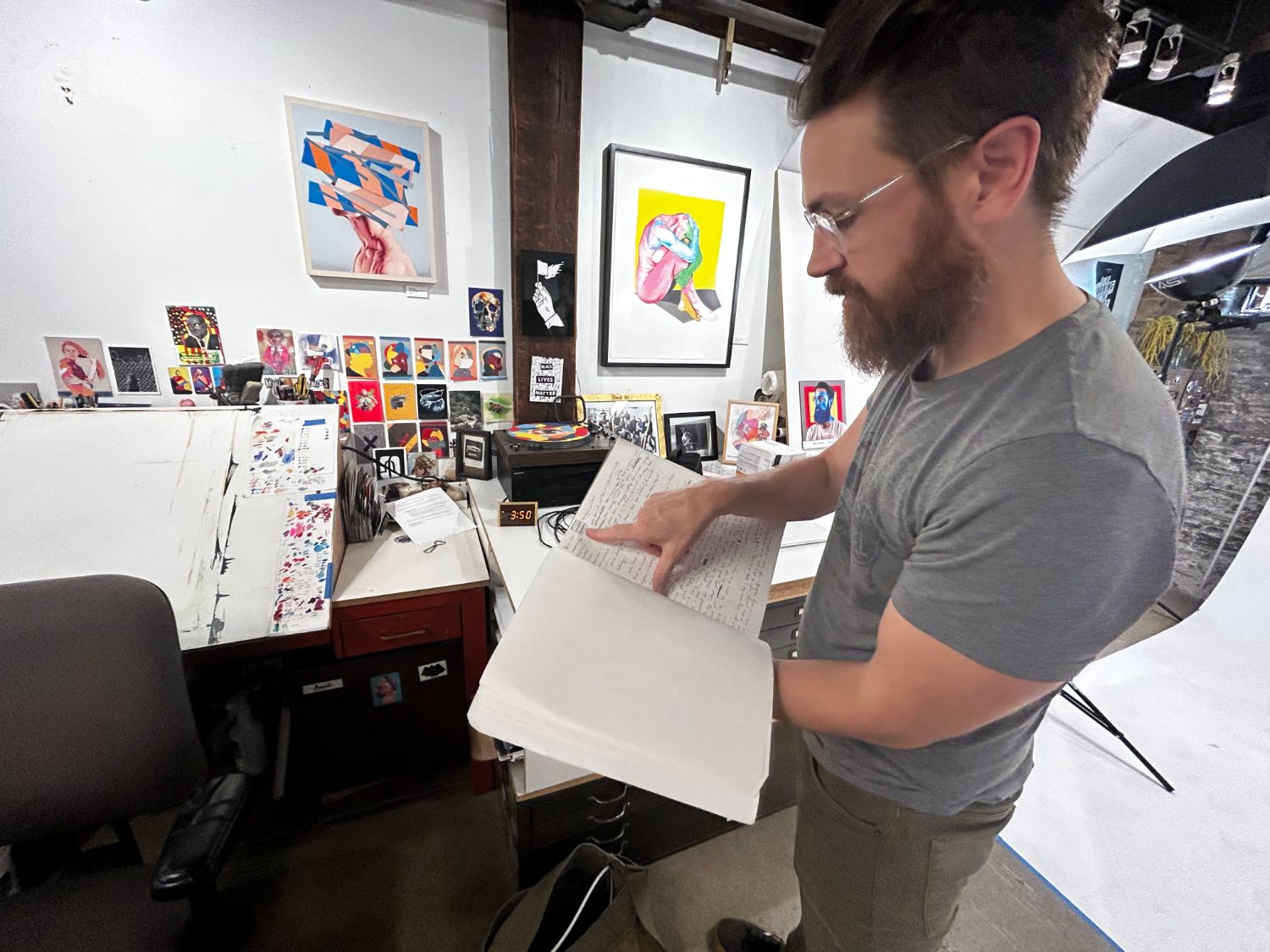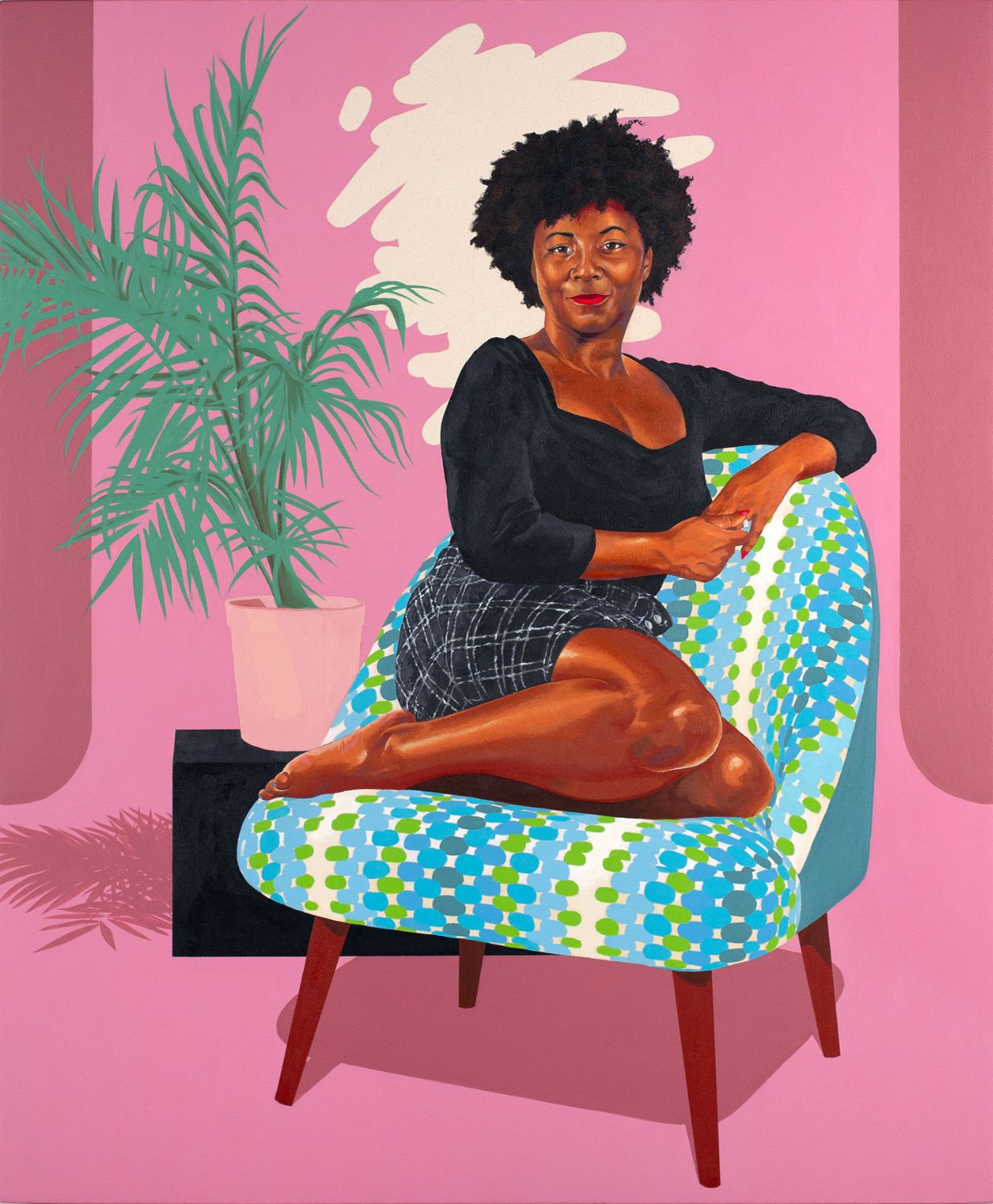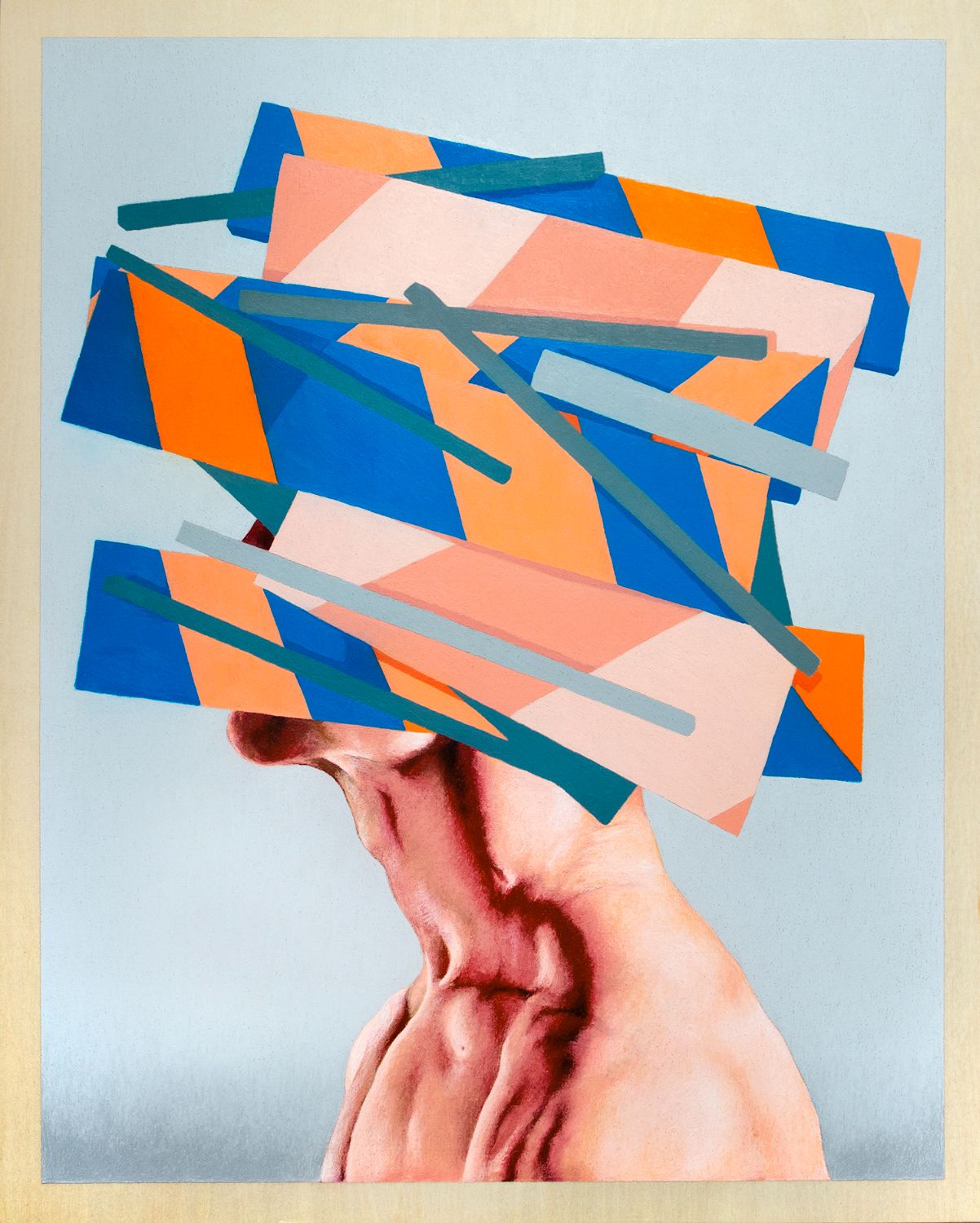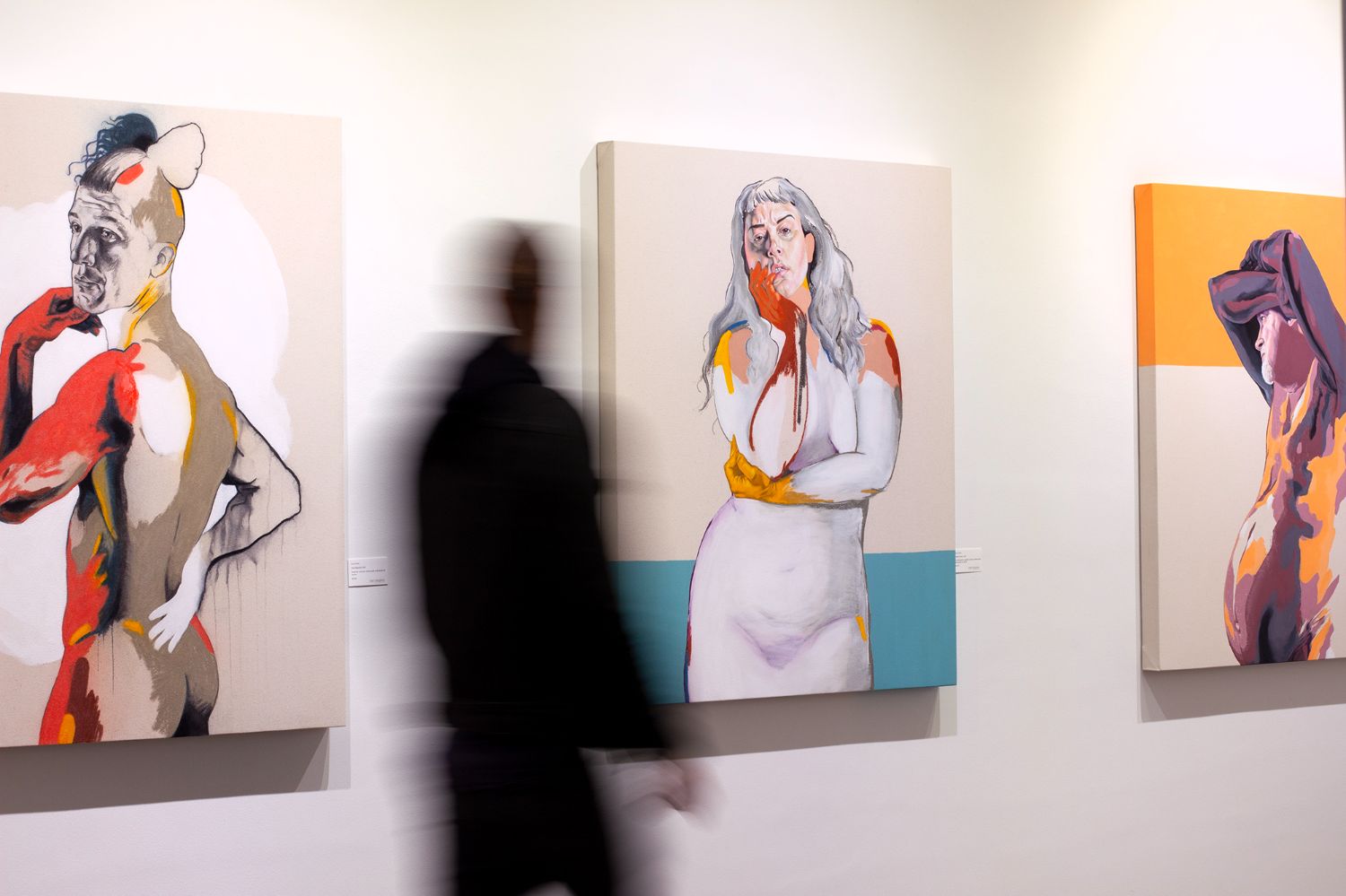
Looking back on 20 Years of MPLSART: Russ White Keeps Going
Published August 20th, 2025 by Carl Atiya Swanson
Artist, writer, and MPLSART's former senior editor reflects on empathetic curiosity, weirdos, and the art of persistence
Artist and writer Russ White in his Casket Arts studio in Northeast Minneapolis. Photo by Carl Atiya Swanson.
An artist and a writer, a pastor’s kid shaped by punk rock, a Twin Cities transplant who has been a contributor to and former senior editor of MPLSART for ten years, Russ White is full of ideas, influences, and stories. With more than 20 solo or duo shows and 40 group shows on his resumé, and more than 120 interviews, reviews, and articles on this very site before he moved into an editor-at-large position after relocating to Zumbrota, his creative output manages to be both meticulous and prolific. On a muggy August afternoon, Russ was in his basement studio in the Casket Arts building, putting the finishing touches on a piece about to head to the Minnesota State Fair Fine Arts Exhibition (part of his Sitters series, featuring recent interviewee Sean Ferris) before sitting down for a conversation about curiosity, liberation, and why we need more weirdos as part of the MPLSART 20th anniversary celebrations.

High Water Mark (detail), 2024. Colored pencil and acrylic on canvas, 45 x 37". Photo courtesy Russ White.
Carl Atiya Swanson: You wrote in your review of Stanley Whitney’s How High The Moon at the Walker, “I’ve never been wild about those lines of tape that museums put on the floor, the ones that mark off the artworks…I always want to get right up on the thing.” That feels like a pretty apt statement for where you want to be not just as an audience member, but as an artist who makes work that is rewarded on close viewing, and as a critic, where your work is to dig in.
Russ White: I think that curiosity is my superpower, if I had one, but it's an empathetic curiosity. It's one that's interested in why people do the things that they do, and also, as a maker of things, how they do the things that they do. And so when I approach, say, a painting in a museum, I'm approaching it both as an audience member and as a peer, as a fellow artist. And what I've kind of realized recently is that one of the ways that I determine whether something is a good painting is if it makes me want to go home and paint, because there's something visceral there in the making that's exciting. There's a sort of, “Oh, I could do that,” kind of aspect to it. And when I'm writing or doing any criticism, I've always framed it as being a translator, because I have the privilege of a background in the arts that most people don't have. I have a degree in studio art, I have an extensive art historical education, and I've had the privilege and honor and ability to go to see a lot of art and meet a lot of artists.
I think artists are endlessly fascinating weirdos of the world, and God bless the weirdos. We need more of them, more of us. So when I go and see a show, I'm not so much interested in answering the question of whether I think the work is "good," or whether it fits my taste. I'm interested in understanding why did this weirdo make this weird stuff, and then why did this space show it in this way, and then what effect do those two elements have on me as a viewer? And so I see criticism as the job of translating another weirdo's obsession through my understanding of art history, through my understanding of pop culture, politics, the world, and then trying to give it some shape that the casual reader can use as a toehold, as a way in. So if you like John Carpenter movies, for instance, you might also like Lindsay Rhyner tapestries, or if you like Egyptian pyramids, you might also like Stanley Whitney paintings.

Russ White offering a peek into his writing process in his Casket Arts Studio. Photo courtesy Carl Atiya Swanson.
CAS: Having been a writer and an editor for MPLSART for the last 10 years, what has having a regular outlet for your writing meant for the way that it's evolved?
RW: It meant that I wrote. I wasn't writing before MPLSART. I was in Chicago and at that point the last time I had written anything with any regularity was in college because I had a deadline for the student newspaper that I was the editor of.
We moved here in 2014 because my wife is from here and her whole family lives here, so the only people I knew were my in-laws, and I was like, I love them to death, but that's not going to cut it. I need to find a community. So I managed to get a studio here at Casket Arts, became very involved in the event planning around the building, and then in NEMAA for Art-a-Whirl and other things and kind of got involved in the art community that way.
In 2015, MPLSART put out this call for prints for an Art-A-Whirl giveaway, and I saw that as another way to reach a new audience and to make some connections. So I brought a ridiculous screen print of Jesus holding a duck, “Lord Love a Duck,”—that was the name of the print —I think it was either that one or “Jesus Saves” where he's like smashing a piggy bank, just stupid funny shit. Blaine [Garrett, MPLSART owner] was like, “Hey, do you know any writers?” and I was like, “Actually... I'm a writer.” So that helped open other doors and kind of propelled me further into this community and gave me a sense of purpose as a writer.
There's a new show every month, or more like ten new shows every month, so there's no shortage of things to write about. It drives me nuts that so much press goes just to the big venues in this town because there are so many things happening in the quote-unquote smaller venues and in artist studios and in these non-institutional spaces that are so interesting and so high quality.
CAS: In a world full of short-form and video content, what is the power of the long-form written word for you?
RW: It helps me understand how I see the world and engage with it. I don't really expect a 2,500-word thinkpiece about a local artist to necessarily gain a huge audience and be wildly impactful on the larger culture. But it's sort of in the same vein as these drawings and paintings that I make: nobody asked me to do these either. So I'm not doing them on behalf of somebody else. I'm doing it because that's how I want to spend my life. It's fascinating and engaging and entertaining.
CAS: There's something that's liberating about that idea that “I do this for me,” and one of the core audiences is the person themselves because they often don't have that kind of outside eye on their work.
RW: This comes directly from my childhood and my theological upbringing, which was that my parents have always been super supportive and super encouraging of any weird flight of fancy that I took as an artist. I want to share that same sense of love and support with everyone in the community.
I remember being interviewed years ago for Project Bike, and there was a film crew here in the studio. Dana Sikkila was working on her documentary and one of the camera operators asked me at some point, “So what advice would you give to an artist who just isn't very good?” I thought for a second and replied, “Same advice I would give to any artist at any stage, which is keep going.” That's the only advice. As long as you're not hurting anybody and you're not stealing from anybody, keep going.

Au Courant, 2025. Colored pencil and acrylic on canvas, 45 x 37". Photo courtesy Russ White.
CAS: Your work obviously centers people and faces and bodies and also is rooted in a real meticulous technique, whether that's with colored pencils or teaching yourself to paint. But it's also balanced out by a looser abstraction that has more fluidity to it. Is that a conscious choice or are you just trying to explore different ways of abstraction? What is the balance between technique and more free flowing work?
RW: Well, that balance is one I'm trying to strike. For me, it's more about speed of production and that I have a lot of ideas and I don't have enough hours in the day to get them out as fully meticulous pictures. It was around 2019 that I was doing these really large-scale works that were very detailed and very photorealistic. One drawing took like 100 hours. I don't have time to do that many drawings if I'm spending two full weeks on one.
I'm also thinking about the effect that Instagram has had on visual culture. I can't speak for everybody, but for me, it opens up a lot of avenues for comparing and, thus, despairing. There was a little bit of a liberation for me in that I would see someone like artist C.J. Hendry, who is a hyper photo-realistic colored pencil artist who does these really immaculate large-scale drawings of objects and things, and I was like, "Well, I'm never going to catch up to her, and it shouldn't be a competition anyway." So then what is the purpose of these drawings? Is the purpose of them to simply recreate a photograph?
Maybe these drawings, if I get looser, if I embrace some abstraction, can actually teach me something about loosening up and not being such a tightass in all aspects of my life, not just in the drawing. People come into my studio now and say, “Wow, your work has changed so much,” and it doesn't occur to me that it has. I think the guts and the bones are still the same.

Blockhead, 2023. Colored pencil on panel, 20 x 16". Photo courtesy Russ White.
CAS: Since you are working with a lot of galleries and seeing people in different settings, how has that practice of going to other people's shows changed the way that you approach your own installation and design process?
RW: I remember Drew Peterson's show at Public Functionary had a real impact on me because of how spacious the installation was. I remember talking to Tricia Heuring about it and she said, to paraphrase, that they didn't feel like the show needed to be too maximalist or overwhelming, that the work could benefit from having a little more room to breathe. And I really took that to heart.
I'm used to showing down here in my basement studio with relatively low ceilings, pipes everywhere. Especially for a show like Art-a-Whirl, you kind of want to pack it in because you want people to have as many little art moments as they can and you want to maybe have a good sales day. So you tend to have a bunch of stuff out, lots of different options. At any kind of gallery where sales isn't necessarily the focus, especially at a college gallery, I really think instead about the viewer's experience.
I think about an art installation in a similar way to how I think about my works, in terms of series. They almost don't make sense to me as standalone pieces. I think of them as a body of work. This was inspired by how George Carlin would try to have a new hour of comedy every year. I really like trying to do that even at Art-A-Whirl or at Open Casket in November. I want to give the viewers a new experience every single time so that even if it's mixing around work that is old or I've shown before, I try to recontextualize it and give them something fresh to engage with so that it's interesting. My number-one rule: "Don't be boring."

This Is Fine, 2024. Colored pencil and acrylic on canvas, 45 x 37". Photo courtesy Russ White.
CAS: You've been doing this for 10 years now, and this is like paraphrasing a question that you asked Tom Hazelmyer, which is, is there something in the water here?
RW: There is something, I think, magical about the Twin Cities and about Minnesota. Coming from Chicago, it was very rare to run into anybody in Chicago. It happened on occasion. Here, it's uncanny. I can't go anywhere without running into somebody I know. I don't know that it's the water or the air or what, but I think the geography has definitely something to do with it — we're far enough away from every other major city that this is where the weirdos come. Also, the Legacy Amendment and that built-in sense of supporting creative endeavors being culturally important to us is one of the reasons that I agreed to move here in the first place.
It's not perfect by any means, and there's a lot of work left to do. It's been interesting to come here in 2014 to see the rise of Northeast. I think when I started participating in Art-A-Whirl, I feel like the headcount was around 30 to 40,000. Now it's well over 100,000 coming through. Some people say that's bad. Some people say that's good. I think there's probably a mix of both, but people are coming out — there is that interest in the arts.
I'd say it's still very hard to sell artwork in Minnesota. I don't know exactly after 11 years of being here what that equation is and how you solve the other side of it. Part of it is that there's maybe a sense of us being provincial or regional. I think there's a sense that when people buy art, a lot of times they do it when they're on vacation and so they're off in the world already spending money with every single decision they're making. When people vacation here, they're typically going to a cabin or something. They're not necessarily going to Form & Content or TOA Presents or whatever, which honestly was part of the reason for MPLSART: To help audiences find these things because people want these things, but they don't know where they are. It's been really gratifying to see the website grow and have more people submit their events and be engaged in actually using the site and seeing our visitor numbers go up year after year.
The thing that I've always said is that we don't need more galleries. We need more gallerists. You need people who want to do that work and then you need them to be able to be successful doing it. Part of that business model is that you have to diversify. What Doug Flanders has done is be very active on the secondary market and not rely just on his gallery shows. And you see what Hair + Nails and Dreamsong are doing by going to these different art fairs and actually exporting what we're doing here. And then what seems provincial in Minneapolis, maybe, is then exotic in New York, or Miami, or LA and it's exciting to be like, “Oh, what are those hicks working on in the middle of nowhere?” Because it's good work!

Somebodies, installation detail. Solo exhibition, The Phipps Center for the Arts, 2024. Photo courtesy Russ White.
CAS: Let's do a quick lightning round. Show or exhibit that made a first big impression on you.
RW: Lee Bontecou in 2004 at MCA. That was one of the best shows I'd ever seen. It was the retrospective when they first debuted her mobiles that she'd been working on in her barn for years. A second art experience that comes to mind was seeing Ron Mueck's piece at the Hirshhorn. It was a giant naked bald man, probably if he stood up would be 20 feet tall, just crouched looking grumpy as fuck in a corner, just an astounding art experience.
CAS: Favorite piece of your own writing.
RW: I'm super proud of my series of McKnight Fellows profiles, which I've been writing since 2019 and which currently stands at 44. But for stand-alone essays, one piece that I always think about was a review of A Letter from the South at City Wide Artists in 2016, because I'm from the South. The artist was from Atlanta, and it was a lot of work about the Black experience in America. That was a moment where I realized that criticism didn't have to just be about what the press release said, and this is what the pictures look like, and you should go before it closes on such-and-such a date, but that you could use art as a jumping off point for much bigger issues and much more interesting topics.
I had a revelation while writing that piece that we think of the South as this hotbed of racism from which the rest of us are immune — or at least above — but when you think about it, every major high-profile police killing up to that point happened above the Mason-Dixon line, whether in Cincinnati or Baltimore or St. Louis or Chicago or right here in the Twin Cities. The letter that this artist was bringing from the South was very applicable to this place and this time right now, and then obviously that bore out very sadly four years later, and remains one of the most pressing and disturbing issues we face.
CAS: Favorite piece of someone else's writing.
RW: I'm going to cheat and use a podcast here. There's a podcast called 60 Songs that Explain the '90s, and the one that host Rob Harvilla did about “Smells Like Teen Spirit” is an absolute masterclass in how to write and about the way that writing can be transportation. He starts with Batman, and then he goes to Wesley Willis, and then he goes to Daniel Johnston, and then he goes to Kurt Cobain, and then he goes back to Batman. That the whole piece is a fabric that he has woven together, not just to be clever, but to really ask a question about, especially around Wesley Willis and Daniel Johnston, what is our relationship to quote-unquote genius when it is comical but based in what is clearly mental illness, and how, as an audience, do we relate to the irony with which we enjoy a song like “I Wupped to Batman's Ass” in relation to the fact that Wesley Willis really did suffer from schizophrenia?
CAS: Artist you’d most like to review or interview.
RW: I would love to sit down with Philip Guston.
CAS: Artist you’d most like to have over for a meal.
RW: Maurizio Cattelan. The banana is brilliant and if anyone says otherwise, send them my way.
CAS: Anything else you want to add?
RW: Fuck all these Nazis. Yeah, that covers it. ◼︎
See more of Russ White's work on his website and be sure to follow his Instagram: @russwhiteart.
This is the first in a series of Q & A articles with the fine folks that have helped make MPLSART what it is over the last two decades. Celebrate the 20th anniversary with us September 27th, 2025, at Southside Preservation Society. Russ will have a never-before-exhibited piece on display at the party as well. Please RSVP and we look forward to seeing your lovely faces at the party.
We can't do it without you.
Help keep independent arts journalism alive in the Twin Cities.